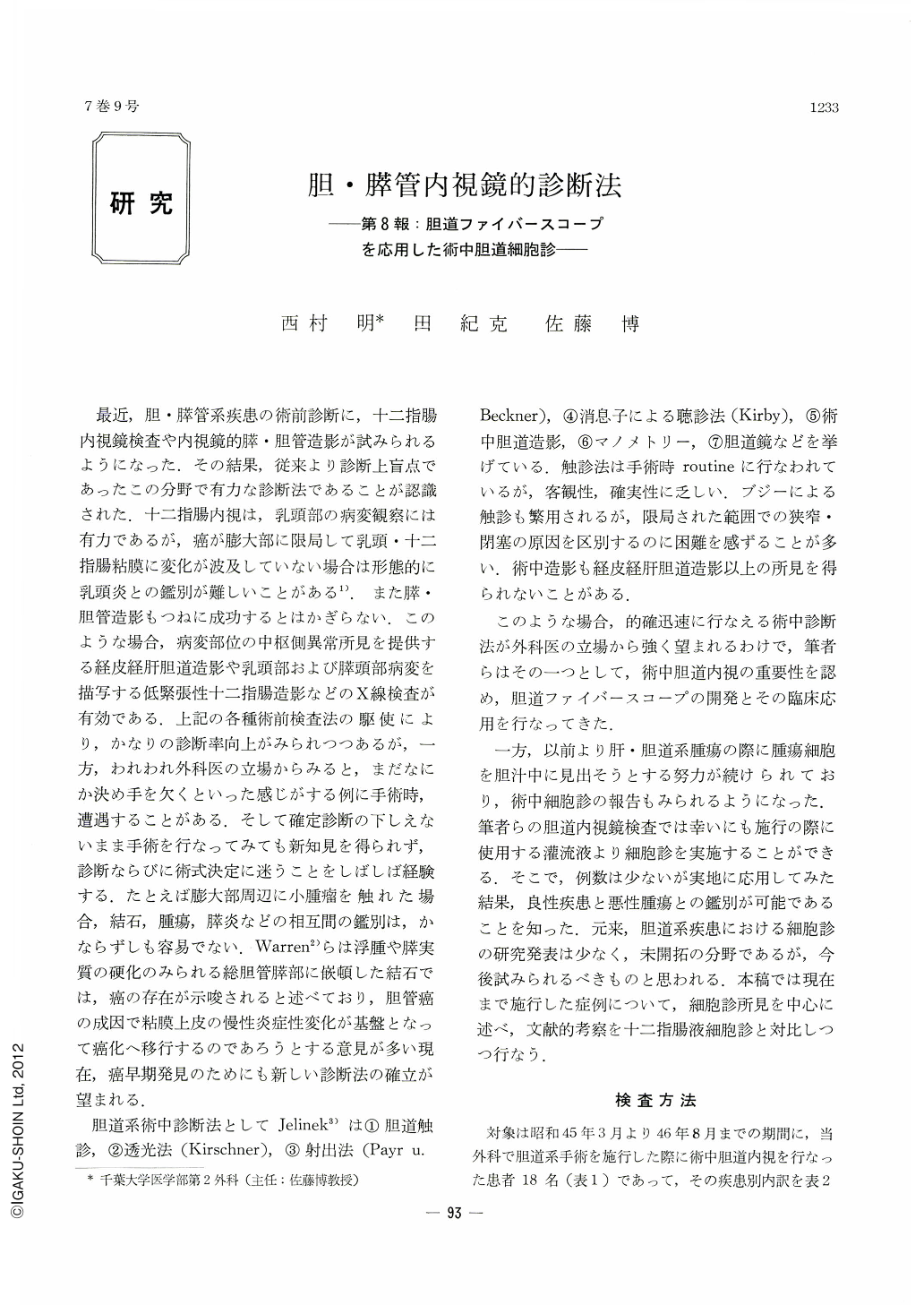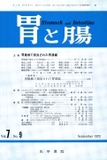Japanese
English
- 有料閲覧
- Abstract 文献概要
- 1ページ目 Look Inside
最近,胆・膵管系疾患の術前診断に,十二指腸内視鏡検査や内視鏡的膵・胆管造影が試みられるようになった.その結果,従来より診断上盲点であったこの分野で有力な診断法であることが認識された.十二指腸内視は,乳頭部の病変観察には有力であるが,癌が膨大部に限局して乳頭・十二指腸粘膜に変化が波及していない場合は形態的に乳頭炎との鑑別が難しいことがある1).また膵・胆管造影もつねに成功するとはかぎらない.このような場合,病変部位の中枢側異常所見を提供する経皮経肝胆道造影や乳頭部および膵頭部病変を描写する低緊張性十二指腸造影などのX線検査が有効である.上記の各種術前検査法の駆使により,かなりの診断率向上がみられつつあるが,一方,われわれ外科医の立場からみると,まだなにか決め手を欠くといった感じがする例に手術時,遭遇することがある.そして確定診断の下しえないまま手術を行なってみても新知見を得られず,診断ならびに術式決定に迷うことをしばしば経験する.たとえば膨大部周辺に小腫瘤を触れた場合,結石,腫瘍,膵炎などの相互間の鑑別は,かならずしも容易でない.Warren2)らは浮腫や膵実質の硬化のみられる総胆管膵部に嵌頓した結石では,癌の存在が示唆されると述べており,胆管癌の成因で粘膜上皮の慢性炎症性変化が基盤となって癌化へ移行するのであろうとする意見が多い現在,癌早期発見のためにも新しい診断法の確立が望まれる.
胆道系術中診断法としてJelinek 3)は①胆道触診,②透光法(Kirschner),③射出法(Payru.Beckner),④消息子による聴診法(Kirby),⑤術中胆道造影,⑥マノメトリー,⑦胆道鏡などを挙げている.触診法は手術時routineに行なわれているが,客観性,確実性に乏しい.ブジーによる触診も繁用されるが,限局された範囲での狭窄・閉塞の原因を区別するのに困難を感ずることが多い.術中造影も経皮経肝胆道造影以上の所見を得られないことがある.
So far reports are not so many for cytology of bile in the diagnosis of diseases in the biliary tract. Mostly diagnosis was attempted by transoral suction of duodenal juice, so that such problems as contamination of cells taken out of extrahepatobiliary tissue or their destruction by bile still remain unsettled. Only recently new experiments on biliary cytology have been reported through application of gallbladder puncture during peritoneoscopy and examination of bile aspirated during percutaneous transhepatic cholangiography.
In the past we have sought to improve the efficiency of choledochoscope by eliminating bile during the examination. First, a balloontipped choledochoscope was devised to remove bile, assuring at the same time a reasonable distance for clear vision in the bile ducts. Then, a newly improved choledochoscope equipped with an irrigation tube was tried not only to prevent extrabiliary leakage of irrigation fluid but, more important, to collect it as well. The fluid, first drained out of the abdomen and then collected in a bottle after circulating the bile duct, is employed for cytological examination during surgical intervention.
By this improved method we have studied 12 cases of benign diseases of the bile ducts, consisting of 11 of stones in the common bile duct and one choledochal obstruction due to a pancreatic cyst. We have also examined six carcinomas of the biliary tract : two carcinomas of the common bile duct; three of the papilla and one choledochal invasion originating from carcinoma of the head of the pancreas. Cytologic changes of all 18 cases are presented in the paper. Cytological diagnosis was accurate in 4 (67%) out of 6 cases of biliary tract carcinoma.
Of two false negative cases, one was classified as class Ⅱ, because carcinoma of the papilla later confirmed in this case had chiefly spread within the submucosa, and scarcely any ulceration was found on the choledochal wall. The other was classified as class Ⅲ, later to be confirmed histopathologically as adenocarcinoma papillare. Cytological examination was after all of no avail in this case. This fact probably suggest its limitation as a diagnostic measure in such a case.
Morphology of malignant cells in the biliary tract is characterized by prominent nucleolus, enlargement of nucleus with some atypia of it.

Copyright © 1972, Igaku-Shoin Ltd. All rights reserved.


